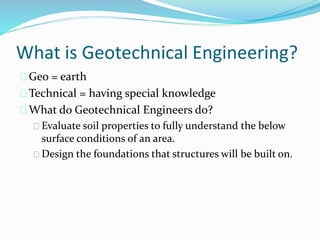See This Report on Geotheta
See This Report on Geotheta
Blog Article
The Best Strategy To Use For Geotheta
Table of ContentsThe 2-Minute Rule for GeothetaThe smart Trick of Geotheta That Nobody is Talking AboutAll About GeothetaThe 30-Second Trick For GeothetaWhat Does Geotheta Do?

They carry out website investigations, gather samples, execute lab tests, and assess data to examine the viability of the ground for construction projects - Geo Tech Engineer. Based on their findings, geotechnical designers provide recommendations for foundation style, incline security, keeping structures, and reduction of geotechnical threats. They team up with other professionals, such as architects, structural engineers, and building and construction teams, to guarantee that geotechnical factors to consider are integrated into the total project layout and execution
By evaluating the behavior and residential properties of soil and rock, they can determine potential geotechnical risks such as landslides, dirt negotiation, or incline instability. Their competence aids stop failures or crashes that could jeopardize lives and property. Right here are some thorough duties and duties of a geotechnical engineer: Website Examination: Geotechnical designers conduct website investigations to collect information on subsurface conditions.
They analyze the information to recognize the residential or commercial properties and habits of the soil and rock, including their toughness, permeability, compaction attributes, and groundwater problems. Geotechnical Analysis and Layout: Geotechnical engineers examine the information gathered throughout website examinations to analyze the security and suitability of the website for building and construction projects. They execute geotechnical computations and modeling to examine elements such as birthing ability, settlement, slope security, side earth stress, and groundwater circulation.
The Buzz on Geotheta
Structure Style: Geotechnical engineers play a critical function in creating foundations that can safely support the designated structure. They examine the dirt conditions and tons demands to establish the ideal structure type, such as shallow foundations (e.g., grounds), deep structures (e.g (https://triberr.com/geotheta)., stacks), or specialized techniques like dirt renovation. They take into consideration variables such as settlement limitations, bearing capacity, and soil-structure interaction to establish optimal foundation layouts
They examine building and construction plans, display website tasks, and conduct area inspections to validate that the layout suggestions are followed. If unexpected geotechnical concerns occur, they evaluate the scenario and supply recommendations for removal or modifications to the style. Threat Analysis and Mitigation: Geotechnical designers evaluate geotechnical dangers and threats related to the project site, such as landslides, liquefaction, or dirt erosion.

Partnership and Interaction: Geotechnical engineers function carefully with various other professionals included in a project, such as engineers, architectural engineers, and building and construction teams. Reliable interaction and cooperation are necessary to integrate geotechnical considerations right into the overall project design and building and construction process. Geotechnical designers provide technical competence, solution inquiries, and make certain that geotechnical demands are met.
The Buzz on Geotheta
Below are some types of geotechnical engineers: Foundation Designer: Foundation designers focus on making and analyzing foundations for frameworks. They evaluate the dirt conditions, load requirements, and website features to identify one of the most proper foundation type and layout, such as shallow foundations, deep foundations, or specialized techniques like stack structures.
They examine the aspects influencing incline stability, such as soil properties, groundwater problems, and incline geometry, and establish strategies to avoid incline failures and alleviate dangers. Quake Engineer: Quake designers specialize in assessing and designing frameworks to stand up to seismic forces. They evaluate the seismic risk of a site, evaluate soil liquefaction potential, and develop seismic style requirements to guarantee the safety and resilience of structures throughout earthquakes.
They carry out area screening, accumulate examples, and assess the collected information to identify the dirt homes, geologic developments, and groundwater problems at a site. Geotechnical Instrumentation Designer: Geotechnical instrumentation engineers concentrate on surveillance and gauging the actions of soil, rock, and frameworks. They install and maintain instrumentation systems that keep an eye on aspects such as dirt settlement, groundwater levels, slope motions, and structural variations to analyze performance and offer early cautions of potential problems.
The 4-Minute Rule for Geotheta
They perform tests such as triaxial examinations, loan consolidation examinations, direct shear tests, and leaks in the structure tests to collect data for geotechnical evaluation and design. Geosynthetics Engineer: Geosynthetics designers focus on the design and application of geosynthetic products, such as geotextiles, geogrids, and geomembranes. They use these materials to improve dirt security, reinforce slopes, supply drain remedies, and control erosion.
They tend to be investigative individuals, which implies they're intellectual, reflective, and analytical. They are interested, methodical, sensible, logical, and logical. Some of them are additionally social, indicating they're kind, charitable, cooperative, individual, caring, useful, compassionate, tactful, and friendly - Tailings Engineer.
In the workplace setting, geotechnical engineers make use of specialized software program tools to perform computations, produce styles, and examine information. They prepare reports, review task specifications, connect with clients and group participants, and coordinate task tasks. The workplace setup gives a helpful setting for research study, analysis, and partnership with various other professionals entailed in the project.
Getting The Geotheta To Work
They often go to task sites to conduct website examinations, evaluate geotechnical problems, and gather data for evaluation. These visits involve traveling to different locations, occasionally in remote or helpful resources difficult terrains. Geotechnical engineers might carry out soil tasting, conduct tests, and screen building and construction activities to ensure that the geotechnical aspects of the project are being implemented appropriately.
Geotechnical engineers additionally work in specialized geotechnical laboratories. Geotechnical lab designers work thoroughly in these atmospheres, taking care of testing tools, operating instruments, and videotaping information.
Report this page